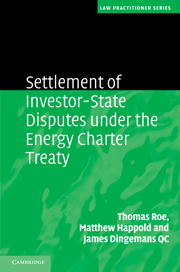Book contents
- Frontmatter
- Contents
- Foreword
- Preface
- Table of cases
- 1 Introduction
- 2 The applicable law
- 3 Availability of dispute settlement under Article 26
- 4 European Union law and the Energy Charter Treaty
- 5 Substantive law
- 6 Procedure
- 7 Contracting Parties' international responsibility for breaches of Part III of the ECT
- 8 Taxation
- Appendix A Selected provisions of the Energy Charter Treaty
- Appendix B Signatories to the Energy Charter Treaty
- Bibliography
- Index
1 - Introduction
International treaty arbitration and the Energy Charter Treaty
Published online by Cambridge University Press: 05 July 2011
- Frontmatter
- Contents
- Foreword
- Preface
- Table of cases
- 1 Introduction
- 2 The applicable law
- 3 Availability of dispute settlement under Article 26
- 4 European Union law and the Energy Charter Treaty
- 5 Substantive law
- 6 Procedure
- 7 Contracting Parties' international responsibility for breaches of Part III of the ECT
- 8 Taxation
- Appendix A Selected provisions of the Energy Charter Treaty
- Appendix B Signatories to the Energy Charter Treaty
- Bibliography
- Index
Summary
Investment treaty arbitration: origins and characteristics
In the beginning was diplomatic protection. Modern international investment treaties seek to provide agreed rules concerning a state's conduct towards foreigners who invest in its territory and a neutral forum for the settlement of disputes between states and such investors. The aim is to promote foreign investment and thus economic development. But this is a relatively recent phenomenon. Traditionally, international law afforded private persons no rights. Only states had legal personality in international law. Only states had rights, duties and the capacity to bring claims to assert their rights. States were obliged to treat foreign investors in accordance with an ‘international minimum standard’ but this obligation could only be enforced by the aggrieved investor's state of nationality. Indeed, the obligation was seen as being owed not to the investor but to its state. As the Permanent Court of International Justice explained in 1924:
by taking up the case of one of its subjects and by resorting to diplomatic action or international judicial proceedings on his behalf, a state is in reality asserting its own right, the right to ensure, in the person of its subjects, respect for the rules of international law.
Diplomatic protection had three major disadvantages. First, from the perspective of the injured investor, it was unsatisfactory because it gave its state of nationality complete discretion whether to make a claim on its behalf or not, the rights in question belonging not to it but to its state.
- Type
- Chapter
- Information
- Publisher: Cambridge University PressPrint publication year: 2011



